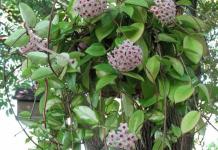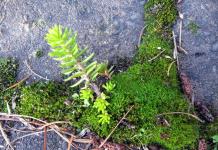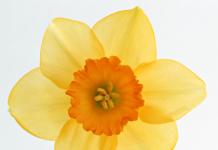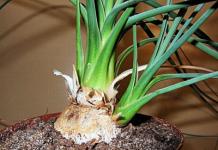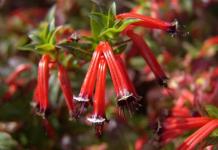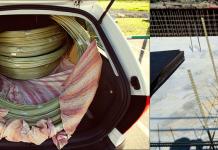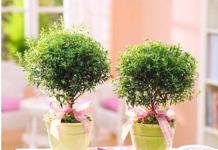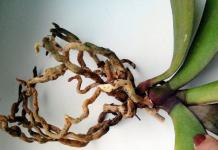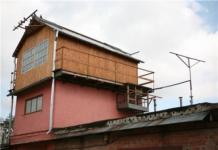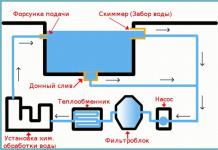Kufea (Cuphea) are perennial and annual herbs and shrubs belonging to the Derbennikov family. This numerous genus consists of about 250 species and lives in the American tropics and subtropics. Some kufei are cultivated to obtain oil from their seeds, others - as honey plants and ornamental plants.
general description
Kufeya is a fast-growing plant with slightly curved, smooth, narrow leaves of a dark green color. Stems up to half a meter long are erect or ampelous.
It blooms from spring to autumn with red, white or purple flowers of an original shape, 2-3 cm long. The shape of the bud of some species resembles a smoldering cigarette, for which it received the name “cigarette tree”. Due to the large number of species, flowers can come in a variety of shapes and sizes. Typically, large-flowered species do not bloom very profusely, while small-flowered species, under favorable conditions, are almost completely covered with buds.
Types of kufei
- – annual flower 90 cm high. Red tubular flowers with a purple or white limb. The leaves are light green.
- Kufeya Fiery Red– a bush up to 35 cm in height with red tubular flowers.

- - an annual hybrid species with red flowers 30 cm high.

- – annual branch up to 40 cm high with branching creeping stems. Flowers are white, lilac or purple.

- Kufeya Issopolistnaya is a bush up to 50 cm high with branching stems and numerous elongated leaves. The flowers are white, pink or red-violet, up to 2 cm in diameter.

- Kufeya Pale compact bush with many red flowers. Widely used as a houseplant.
Caring for kufeya
The plant is more suitable for flower beds, but due to the beauty of the flowering bushes it is successfully grown as a potted plant. In indoor culture, kufeya grows quickly and can reach a size of 40-60 cm in both height and width. It is grown as a bush or hanging plant.
Temperature and lighting– the plant needs good lighting, but it must be protected from direct rays of the sun at midday. If there is a lack of light, flowering will be scanty or not at all.
In summer, kufeya will grow at normal temperatures, and in winter it should be reduced to 10-18 degrees, but not lower than 8. In summer, the plant can be taken outside or onto a balcony, but remember that it really does not like drafts.
Humidity and watering– the plant should be watered very generously, draining the water from the pan after 30 minutes, but between waterings the soil in the pot should dry out slightly. In autumn, watering is gradually reduced. Good drainage is needed, since stagnation of moisture at the roots is unacceptable.
Every other day, the kufeya needs to be sprayed, especially in the summer or if it overwinters in a living room with dry air. Sometimes it should be rinsed in the shower.
Fertilizer and feeding– during the growing season, twice a month with fertilizers for ornamental flowering plants.
Soil and replanting– suitable soil for ornamental flowering plants, you need drainage and a pot of regular shape. Young kufei are replanted annually, and adult plants are replanted in the spring into a slightly larger container when they have entwined their roots around the entire earthen ball.
Flowering and pruning– blooms profusely from the first year of life in June-November. Kufeya grows very quickly and reaches its maximum size within a year. In early spring, as soon as new leaves appear, it is cut off by two-thirds. Throughout the season, young shoots are pinched, strongly - if you grow it as a bush, a little, just so that more side shoots are formed - if it grows as an ampelous plant.
If a plant has lost its decorative appearance over the winter, you can throw it away after rooting the apical cuttings. They will bloom at the same time as the adult plant. In summer, the plant can be planted in a flower bed, and in the fall it can be brought indoors.
Reproduction of kufei
Kufeya is propagated using cuttings or seeds.
Vegetative propagation
In March-April, during pruning, cuttings at least 7 cm long are taken, the lower leaves are torn off, the cut is treated with a root formation stimulator and planted in a sand-peat mixture. The planting is covered with a transparent film and rooted at room temperature, regularly moistening and ventilating.
After rooting the cuttings, they are planted in several pots for greater decorativeness. Kufeya can be successfully propagated by placing its branches in a glass of water.
Seed propagation
Kufei seeds have poor germination; in order to get several plants, you need to sow quite a lot of them. In the spring, scatter the seeds over the surface of the soil, press them lightly, spray them with a spray bottle and cover with glass, without sprinkling soil on top. Place the container with the sowing in a bright place with a temperature of 18-22 degrees, regularly moisten and ventilate.
Remove the glass after the shoots appear, and when they grow a little, drink them into small glasses.
Pests, diseases and possible problems
- Kufeya can be affected by aphids and spider mites. Treat it with an insecticide.
- The plant may rot if it is systematically overwatered.
- Leaves may fall if the kufeya is in a draft.
- Gray spots on the leaves may indicate the appearance of a fungus or gray rot - cut off the affected parts and treat the plant with a systemic fungicide.
- Kufeya is prone to chlorosis - if its leaves turn yellow but remain elastic, pour it with iron chelate, or even better, spray it over the leaves.
Kufeya is a fast-growing shrub. He belongs to the family derbennikovykh, and the traditional habitat is Central and South America.
Kufeya comes from the Greek word "Kyphos", which means "hunched over, crooked".
Indeed, its leaves and fruits bend slightly.
The plant has smooth, dark green, narrow leaves. The stems of shrub species grow up to 40-50 cm in height. The flowers reach a length of 2-3 cm and can be red, white, purple and other colors. Flowering lasts all warm period, from spring to autumn.
Photo
Kufei flower photo:




Kinds
In nature there are about 200 different types of kufei. Annuals grow to a height of 1 meter. Perennials - usually small shrubs, used when planted in concrete flowerpots. The following types are most popular among gardeners and indoor plant lovers:
Fiery red Gelya
This flower is usually grown as a potted flower, but it can be planted with great success in a flower garden in a summer cottage. As it grows, it becomes a small bush on which bright red, tubular-looking flowers bloom. It can be propagated by both seeds and cuttings. There are several subspecies: "Coan" the flowers are brick red or cream, and "Dynamite" blooms earlier than all other species with bright red flowers. See the photo of “Fiery Red Gel” below: 
Hyssopolis
a small bush-like plant from Guatemala and Mexico. Prone to warm weather, but can grow in rain and wind conditions. It grows as a bush up to 50 cm high. As a rule, this species is planted in containers on balconies and courtyards. Very easy to propagate using cuttings. The flowers are white, pink or lilac, small, but usually there are a lot of them on the bush, and flowering time takes all summer. Below we can see a photo of the “hyssopolous” kufei: 
Home care
Caring for kufeya is not difficult, the main thing is to provide conditions for temperature and abundant watering. Can't be allowed freezing the plant and being in a draft.
Care after purchase
 Kufeya can often be purchased at garden centers as a ready-made plant.
Kufeya can often be purchased at garden centers as a ready-made plant.
After purchase, in mandatory it is necessary to transplant into a new pot or flowerbed on the site.
IMPORTANT!
To facilitate planting, the root system can be closed special bag, which ensures easy separation of the plant from the soil.
However, if it is not removed, the fabric will stop allowing water to pass through to the roots, and the flower will begin to rot. will die. In addition, transplantation is carried out not by transshipment of an earthen clod, but by the most complete cleansing of the root system from the transport substrate.
Trimming
The plant very quickly reaches its maximum height, so to stimulate branching and form a beautiful crown it is necessary to constantly perform pinching of shoot tips and corrective pruning. If a perennial plant is grown, pruning is done at the beginning of spring before active development and preparation for flowering began.
On fiery red kufei, only pruning of elongated shoots is usually performed. You need to spend more time on the issopolis formation - due to its strong branching, this plant can be given the appearance of a ball or a pyramid.
Watering
In the summer, both indoor and garden kufeya are watered in moderation with water at room temperature. In autumn, the procedure is performed once every 2-3 days. In winter, the amount of water is reduced, but the coma should not be allowed to dry out too much.
In spring and summer, during flowering, mineral fertilizers can be added to the water at the rate of 20 grams per bucket.
Planting and soil
To plant kufei, fertile, nutritious soil is required. You can make it yourself by mixing 1 part each of leaf, humus, peat and turf soil, and half a part of river sand. If this is not possible, then purchasing universal slightly acidic soil is allowed.
When growing kufei outdoors, it is moved there after a significant increase in the average daily temperature - best in late May or early June. The place for planting should be sunny, the soil should be soft and fertile.
Transfer
 When growing kufei as a houseplant, it must be replanted annually in early spring, before the flowering period begins. At the same time, you can trim or pinch.
When growing kufei as a houseplant, it must be replanted annually in early spring, before the flowering period begins. At the same time, you can trim or pinch.
The pot can be selected from any material, but must have holes in the bottom. Size - 2-3 cm larger in diameter than the previous one.
As soon as the capacity reaches 25 cm, transplantation is performed once every 2-3 years. A thick layer of expanded clay drainage or brick chips is poured down.
Growing
Where to grow Kufeya? Gardeners living in the southern part of the country can grow kufeya outdoors as an annual crop.
The flower is planted in the garden no earlier than the end May as soon as the chance of frost has passed.
You need to choose a place with good lighting, but partial shade is also allowed. You cannot plant kufeya in a damp place where there is no air movement. The gap between the bushes should be at least 30-35 cm.
Reproduction
The flower propagates by cuttings or seeds.
Cuttings are cut from the top of the plant and planted in the ground in early spring, when the air temperature reaches +18 degrees, or they are rooted in a glass of water.
 To ensure the shape of the bush, you can plant 2-3 shoots in one place at once.
To ensure the shape of the bush, you can plant 2-3 shoots in one place at once.
When the cutting starts to grow and three additional pairs of new leaves grow, the top is pinched off.
Seeds are sown in the ground in March-April, the main thing is that it is already warm and the sun is shining brightly. They are not sprinkled with earth on top. For best germination, it is advisable that the outside temperature be at least +18 degrees. You can also place the seeds in a bowl, cover it with a bag, and put it in a warm place. After germination, they are planted in disposable cups, and then, as they grow, in soil or a large pot.
Temperature
Kufeya is thermophilic. In summer, it grows well at room temperature +22-25 degrees.
In winter it is lowered to +12-18 degrees, but not lower.
The flower does not tolerate low temperatures and cold drafts.
When grown outdoors, the bush is either used as an annual plant or dug up and moved indoors for wintering.
Lighting
The plant should be in a bright place, with shade from direct rays. In an apartment, these can be east or west windows. If there is not enough light, the kufeya will not bloom, and the leaves will lose their color and be dull. When they get sunburned they turn red.
Benefits and harms
Plants are not poisonous or toxic. In some countries, kufeya is planted to obtain seeds. Fatty acids are made from them, which are used for industrial and domestic purposes.
Diseases and pests
The flower is not inclined to pest infestation, however, spider mites or scale insects may appear on it.
 When damaged by spider mites, a thin white cobweb forms on the leaves.
When damaged by spider mites, a thin white cobweb forms on the leaves.
At the initial stage, it is enough to carefully wash the plant with a soft sponge and soapy water.
In neglected form, after washing, you will still have to spray with chemicals.
When scale insects appear, brown protuberances, which are the shells of these insects, are clearly visible on the leaves.
To combat it, you need to wash all the leaves on both sides with a brush and soapy water, mechanically removing the pest. If necessary, after this you can still treat with insecticides.
The appearance of gray spots on the leaves and rotting of the stem is the result of the appearance of fungi and gray rot. It is necessary to treat the plants with fungicides against rot.
Attention! Being in a draft can cause leaves to drop.
Conclusion
Kufea is a popular garden plant grown for its colorful flowers. It can be used both in an apartment in pots and on a personal plot in open ground. When leaving you need comply with watering and lighting conditions. Due to its rapid growth, constant pruning and pinching is required.
If you find an error, please highlight a piece of text and click Ctrl+Enter.
Cuphea or Japanese myrtle is an annual and perennial herbaceous plant, as well as shrubs, belonging to the family Derbennikov. In the natural environment, these interesting and unusual plants are common in temperate, tropical and subtropical climate zones of America (southern and central parts).
The name of the plant comes from the Greek word “kyphos”, which means “crooked, bent”. After the end of flowering, curved fruits are set; most likely, the name of the plant was given due to this.
Kufei has a compact appearance. The stems are erect, dotted with small oblong leaves with entire edges and sharp tips.
When does kufeya bloom?
The flowering period of kufei is long: it begins in early spring and lasts until October. There are as many inflorescences as there are leaves, but they do not compete with each other, but only complement each other, the bush becomes exquisite and very elegant.
The flowers are tubular in shape, with six petals in almost all species (the upper two petals are usually larger in size). Modest flowers can be white, pink, lilac, red. It’s as if nature specially created kufeya for lovers of meditation - the plant does not have huge inflorescences or “screaming” forms; admiring the plant, the soul is filled with peace and tranquility. By the way, the stems of the plant are a little sticky; if you plant tall bushes around the perimeter of the plot, you will protect your yard from the unceremonious invasion of your neighbor’s pets.
Frost resistance of kufei
Kufeya is simultaneously among the indoor and garden plants. In the conditions of central Russia, annual species and varieties are grown seasonally in open ground, and perennials are cultivated as indoor plants. Flowerpots with flowering bushes become decorations for the garden, veranda, and balcony during the warm season. In October, bring the containers with the plant into a cool but closed room, and when frost sets in, return them to their usual place (in the room). Kufeya is capable of wintering in open ground only in the southern regions of the country. The most frost-resistant varieties can withstand a maximum of 12°C below zero.
Even in its homeland, kufeya became popular in gardening some 15 years ago. In Arizona, in the late 80s, active work began on breeding new interspecific hybrids, but the results of their work have not yet reached European countries. Growing kufeya is not difficult, but due to its heat-loving nature, it has its own difficulties.
Growing kufei from seeds
When to plant
Annual and perennial species can be grown from seeds, but in seedlings. We start sowing in early spring, at the end of February - beginning of March. Place a layer of drainage (pebbles or expanded clay) at the bottom of the sowing container, add a universal soil mixture for growing seedlings (it is recommended to supplement it with perlite or wet peat) and level it.
- spread over the surface of the soil, only slightly deepening, moisten by spraying with a fine spray.
- To create a greenhouse effect, cover the top with transparent glass or film.
- Provide diffused lighting and maintain the air temperature within 22-25 °C, also raise the shelter daily for ventilation, periodically spray the crops or use bottom watering (moisturize in this way so that the seeds do not “drown”).
- When the sprouts appear, you can remove the shelter for a while so that they can successfully adapt; in the future we will grow without shelter.

- Dense crops need to be thinned out, and when the seedlings grow, plant them in separate containers.
- Caring for seedlings consists of moderate watering; when the third pair of true leaves appears, pinch the top.
Seedlings intended for transplantation into open ground need hardening. To do this, 7-10 days before transplanting, begin to take the plants outside, increasing the time spent in the fresh air each time until the seedlings can spend the night in such conditions.
We carry out transplantation with the establishment of real heat in your region. Dig up the area, remove weeds and debris, level the ground and make holes in accordance with the size of the root system. It is preferable to use the transshipment method. Lightly press the soil around the seedling with your palms and water, maintaining a distance of about 25 cm between individual plants.
Useful properties of the plant
In America, annual kufei are grown on an industrial scale. The seeds are processed to produce fatty acids, including laurel. These substances are used in the production of shampoo and other household chemical products.
At the energetic level, the plant helps bring people closer together - pretty bushes are often placed in offices and meeting rooms. If you grow kufeya in a living room, the plant “shares” its vigor and creates a favorable atmosphere in general.
Planting and caring for kufeya in open ground
Site selection and lighting
Dark spots can be found on the leaves - heralds of waterlogging of the soil. It is necessary to treat the plant with a fungicide and adjust watering.
Dampness can cause the root collar to rot or gray rot to appear. We also save the plant with a fungicide.
Pests of kufei are not numerous: red spider mite (most often appears when indoor air is very dry) and whitefly. First, we bathe the plant under a warm shower, then treat it with an insecticidal solution.
Vegetative propagation of kufei
Kufeya is propagated vegetatively in several ways.
Cuttings
This method is mainly used. For rooting, cut apical cuttings 10-15 cm long in the spring, plant them in containers with a sand-peat mixture and root at a temperature of 18-20 °C. To speed up the process, cover the top with a glass jar or cut-off plastic bottle, and also maintain diffused lighting. The appearance of new leaves indicates that the cutting has taken root. After some time, transplant into a separate container, and transplantation into open ground can be done next spring.
Dividing the bush
This method is applicable to perennial, well-grown bushes. In the spring, dig up a bush, divide it into several full parts (each of them should contain part of the rhizome with growth buds and shoots). We plant the delenki in individual containers or plant them in open ground.
By layering
The method is applicable to kufeya, which is grown in open ground. It is necessary in the spring to bend the outermost shoot to the soil surface, cover it with soil (the top of the shoot should be above the surface) and water throughout the season. By autumn, a young sprout will appear, which should be separated next spring and planted separately.
Care and cultivation of kufei video:
The best types and varieties of kufei
About 250 species of kufei are common in the natural environment, and thanks to the work of breeders, the number has been replenished with a dozen varieties. We will consider the most popular representatives grown culturally.
Cuphea procumbens Cuphea procumbens

An adult bush reaches a height of about half a meter. The stems and shoots are densely dotted with small leaves; during the flowering period they are joined by lovely white or purple flowers. It is easy to grow from seeds (they have good germination; in the southern regions they can be sown immediately in open ground), but are not very often found on sale.
Cuphea fiery red Cuphea ignea or Cuphea platycentra

The species is widely popular both in gardening and indoor growing. Indoor kufeya should be taken out into the fresh air to decorate a balcony, veranda or garden in late May-early June. The compact bush is decorated with red tube-shaped inflorescences with a dark tip, which resembles a smoldering coal.
Cuphea pallida

An annual plant in the form of a shrub. The stems are decorated with dark green leaves, then joined by small wine-colored flowers. Such kufei are planted in a flowerbed and used in single or group plantings. Graceful bushes are grown in containers and hanging pots.
Cuphea hyssopifolia

The bushes are small in size, they do not fall apart and hold their shape perfectly even in strong gusts of wind or rain. It is mainly propagated by cuttings (growing material is available in flower shops as early as May). The flowers are small, white, pink or lilac, but they completely adhere to the bush. The species is very thermophilic and needs fairly abundant watering. Most often, kufeya issopolis can be seen in containers on balconies and patios.
Cuphea lanceolata

A bush almost a meter high (about 90 cm), this species can be planted to “fence” an area. The flowers are long tubes, their color is dark purple. The flowering period lasts from July until the onset of October cold weather.
Cuphea miniata ‘Firefly’

Kuphea miniata Cuphea miniata ‘Firefly’ photo
Kufeya “Burning Fire” - the variety can rightfully be called the best work of breeders. The bush is compact, most often grown as a hanging plant. Even among the huge variety of flowers, you cannot remain indifferent to this plant. Against the background of dark green leaves, bright red flowers “flare up”, cascading down.
Kufeya is part of the loosestrife family; about 200 species of this plant are found in the wild in South and Central America.
Among these species there are annual plants reaching a meter in height, as well as low-growing shrubs and subshrubs. Shrub plants are extremely popular in Europe when grown in containers.
General information
The flowering period of kufei lasts quite a long time, for several months, but each bud does not bloom for long. To increase the duration of the flowering period, faded flowers are removed, and to achieve abundant flowering, the plant is planted in a container that is not too spacious.
Several kufei are considered especially valuable species. Such as ignea or Platycentra, hyssopifolia and micropetala. All these plant varieties have gained immense popularity among their genus.

Types and varieties
A shrub or semi-shrub plant reaching up to 50 centimeters in height. The leaves are arranged oppositely on short petioles, reach up to 2.5 centimeters in length and 0.5 centimeters in width, with a dark green color, lanceolate in shape.
The flowers are solitary, quite small, axillary, reaching up to 1 centimeter in diameter, and have a white, pink or lilac color. This type of plant has a fairly strong bushiness and compact size, for this reason it can easily be grown as a bonsai.

It grows as a subshrub, reaching up to 40 centimeters in height. The leaves are ovate-lanceolate, arranged oppositely on short petioles, reach up to 6 centimeters in length and 2 centimeters in width, and have a dark green color. Axillary single flowers reach up to 3 centimeters in diameter and are red in color with a purple edge.

It grows as a shrub plant, reaching 30-40 centimeters in height. The leaves are small and narrow, somewhat similar to the leaves of the hyssopolis kufei. The flowers are also not particularly large, but appear one after another slightly above the axils of the leaves, their calyxes are yellow, closer to the base they are scarlet, with a greenish throat, the stamens are red.
There are six petals, but they are so small that they are hidden by the teeth of the calyx, which is where the name of the plant comes from. The plant is propagated mainly by cuttings, although it produces a large number of seeds.

Kufeya care at home
The plant develops well if it is provided with the necessary temperature conditions, which in summer should range from 20 to 25 degrees, and in winter from 15 to 18 degrees.
Kufeya feels good in bright rooms; it can be placed near windows of eastern and western orientation; the plant responds quite well to a certain amount of direct sunlight.
In summer, the plant is provided with abundant watering after the top layer of the earthen clod has dried. In the autumn, watering must be reduced, and in winter it is reduced to moderate, preventing the soil from completely drying out.
Spraying of the plant is carried out only periodically, from time to time, since kufeya tolerates low air humidity in the room quite well.

Kufeya replanting and fertilizers
The kufei plant needs to be replanted annually in the spring. To do this, make up an earthen mixture of equal quantities of leaf soil, turf soil, peat soil and humus soil, with the addition of ½ part of sand. It is imperative to place good drainage on the bottom of the dish.
Between April and August, the plant needs mineral fertilizer for flowering indoor plants. Feeding is carried out once every 2 weeks.

Pruning kufei
The main care for the kufei plant is rightfully considered to be annual pruning in the spring, and pruning itself consists of transforming the crown to the desired size and shape.
Most often in our area, fiery red kufeya is grown as a balcony plant and when pruned, only elongated shoots are shortened, but with kufeya issopolis the situation is a little different; it needs to ensure a more thorough formation of the crown.
During the summer period, maintaining the shape of the crown is possible only by periodically pinching the tips of the shoots. But in other periods, due to the strong bushiness of the plant, any crown can be formed, in the form of a pyramid or a ball.

Reproduction
Most often, the plant is propagated by semi-lignified cuttings in the spring or at the end of summer. In some cases, seeds are used.

Pests and diseases
Kufei is very rarely damaged by diseases, but among the pests, you can sometimes find spider mites.
Kufeya is an evergreen shrub with flowers of an unusual tubular shape, reminiscent of lit cigars, for which it is also called the cigarette tree. Belongs to the loosestrife family, is of Mexican origin and has a Greek name Kyphos, which translates as “crooked” or “bent.”
The main habitat is Central and South America, where there are up to two hundred different subspecies of kufei. There are two main types of plants: annual and perennial. The height of the stem can reach half a meter. The leaves are dark green and narrow in shape. The flowers come in a variety of colors, but white, red and purple are the most common. Flowering lasts throughout the warm period. Lushly blooming kufei are a delightful decoration for your home, balcony or garden.
Types of kufei grown at home and in gardens, as well as their photos
Among all existing types of kufei, two are especially popular as garden and indoor plants: Fire-red and hyssopolis.
– this species is often cultivated as a houseplant, also for decorating open flower beds. This species of flower is sometimes grown in large containers that are placed in patios.
In appearance it is a low compact bush with tubular flowers in the shape of a cigar. The corollas are painted bright red, against which there is a contrasting white spot. In the center of the bud there is a purple throat.

Photo. Fire red cupheaignea
There are several cultural variations of the fiery red kufei, which look like small neat bushes, the height of which does not exceed 30 cm:
- Coan – corollas can be brick red or creamy white;
- Dynamite – flowers of a rich red tone are formed quite early with the onset of the warm season.
– The plant is native to Mexico and Guatemala. It is distinguished by its endurance and is not afraid of rainy or windy weather. The bushes do not exceed half a meter in height. The flowers are small, usually a large number of them appear at once, flowering continues throughout the summer. Flower color can be white, pink or lilac.

Photo. Cupheahyssopifolia (Cupheahyssopifolia)
In open ground, kufei are most often grown in warm climates. The plant can also be perfectly adapted as a border plant. For decoration, it is grown in pots and containers, which are placed in patios, balconies and loggias. The plant looks good in hanging pots, in which flowering stems gracefully hang.
It is preferable to place the kufeya in places where there will be natural shading during the midday heat. It is also necessary to provide light, loose, but nutritious soil.

Place the kufeya where there is sufficient light.
If you plan to transplant the plant from a room to open ground, you must first harden the seedlings. Replant only after the end of spring frosts, prepare fertile soil. In the garden, choose a place that will be well lit during the day, or, in extreme cases, will have weak shading. Caring for a plant in open ground will include regular weeding, pinching and pruning.

The basic rule for caring for kufeya at home is protection from cold and drafts.
Caring for kufei at home is generally not difficult at all. For growing indoors, annual plant species are most often used. Seeds are used for planting. The basic rule for caring for indoor kufeya is to protect the flower from cold and drafts and ensure abundant watering.
Is a transplant necessary after purchase?
Kufeya can be purchased at special gardening centers, where it is sold in the form of an already grown young plant. After purchase, it is necessary to replant the flower.. Often, on sold specimens, the root system is protected by a special bag. It is necessary for ease of separation of the root system from the soil. However, it should be removed because the tissue will prevent water from reaching the roots and lead to rot. When replanting, they do not use the method of transferring an earthen clod, but clean the root system as much as possible from the transport substrate.
Pruning kufei
Kufei growth usually occurs very quickly and the stems can reach their maximum height in a short period of time. In order for the plant to acquire a beautiful and well-groomed appearance, it is necessary to stimulate branching, while forming a neat crown. To do this, it is necessary to regularly pinch the tips of the shoots and do corrective pruning.
 Eustoma flowers and their cultivation from seeds at home, as well as a lot of other useful information.
Eustoma flowers and their cultivation from seeds at home, as well as a lot of other useful information.
Diseases of the Howeya palm and not only can be found at the link http://cveti-rasteniya.ru/xoveya-uxod-v-domashnix-usloviyax.html
For fiery red kufei, it is enough to trim off excessively elongated shoots, while the formation of hyssopolous kufei will take longer, because its strong branching allows you to create original geometric shapes, for example in the form of a pyramid or a ball.
On perennial plants, pruning begins in early spring. It must be done before the period of active growing season and flowering. At the same time, shortening the stem by one third will help stimulate the growth of young shoots.
What kind of watering is needed?

At home, kufeya is very demanding when it comes to watering.
Most of all, kufee requires regular, abundant watering in home care.. It is necessary that the soil is thoroughly saturated with water, which should always be inside the pot.
The watering regime should be at least twice a week. For irrigation use water at room temperature. It is necessary to ensure that each subsequent watering is carried out after the top layer has dried.
Excess moisture also does not benefit the plant, so to avoid stagnation of water, good drainage should be ensured in advance. In winter, watering is slightly reduced.
The flower can withstand short-term drought quite steadfastly. Kufeya is not very demanding on air humidity and there is no need to spray it often, but it can be placed under a cool shower from time to time.
Planting and soil requirements
For proper care, it is of great importance where to grow kufei. To prepare fertile and nutritious soil for a plant, you need to mix one part of the following types of soil: leaf, peat, turf, humus, and also half of river sand. A universal slightly acidic soil is also suitable.
For good growth and flowering, kufee requires feeding. Organic types of fertilizers are most preferable for her. You can use complex mineral compositions.
Important! During the warm period, the plant is fed during daily watering, using 20 g of liquid fertilizer diluted in a bucket of water.
The flower also benefits from spraying with a water-soluble complex fertilizer used for foliar feeding. During the flowering period, fertilizers for flowering plants are suitable.

Kufeya is replanted annually in the spring.
If kufeya is grown from seeds, an annual spring replanting will be required.. In this case, it is better to transplant into flower pots in a specially prepared soil mixture. It can be prepared in the following proportions:
- sterilized soil – 50%;
- neutral peat – 25%;
- sand – 25%;
- mineral fertilizers - 40g per bucket of soil.
When choosing a pot, the material from which it will be made does not matter much, but the presence of holes in the bottom is a must. The size of each new pot is chosen 2-3 cm larger than the previous one. When the container size reaches 25 cm, transplantation can be done less frequently, once every two or three years.
Growing
Cultivating kufei both on the site and at home can be done quite easily, the main thing is to follow all the rules for caring for it.
Methods of propagation of kufei (seeds, cuttings)
To propagate kufei, you can use seeds and cuttings. By the way, the very name of the flower from Greek is precisely related to the curved shape of its seeds. They are greenish-brown discs with a curved shape up to 3 mm in diameter. As a rule, they germinate within 5-7 days. If they are placed too close together, they may stick together because they begin to secrete a sticky substance during germination. You can place the seeds in small containers, cover them with a bag, and place them in a warm place. When they germinate, they can be planted in disposable cups, and after a while - in a permanent place.

Kufeya propagates well both by seeds and cuttings.
Seeds are highly sensitive to light. They do not need to be covered too much with soil, you just need to press them a little into the soil, because... in the light they emerge much faster. During seed germination, a temperature of 20-22 degrees is required. When planting seedlings, the containers must be placed in the sun. Young shoots begin to be planted at the end of May.
When propagated by cuttings, they are cut from the tops of plants diagonally, using a fairly sharp knife, and planted in the ground at the beginning of spring when the air warms up to 18 degrees. You can also root in a glass of water. Roots usually appear within a week.
 Torenia flowers, how to grow them at home, can be found here.
Torenia flowers, how to grow them at home, can be found here.
A beautifully flowering herbaceous plant of the acanthus family - thunbergia, its planting and care.
It will be easier to create the shape of a bush if you place two or three shoots in one place at the same time. During the beginning of growth, new leaves appear on the cuttings, then the top is pinched off.
Temperature and lighting requirements
Kufeya is quite thermophilic and needs moderate air heating. In summer, the temperature should be 22-25 degrees, and in winter - not lower than 12-18. Too cold air can be detrimental to a flower.
For good vegetative development, the flower requires bright sunlight. It is best to grow kufeya at home on eastern, or at least western, windows. Northern window sills are unfavorable for the plant, the flowering of which will be incomplete due to lack of light, and the leaves will become dull.
Important! If the plant gets sunburned, the leaves will suddenly turn red.
Diseases and pests

Spider mites are quite rare on kufei.
Among the most common signs of kufei diseases, several should be highlighted:
- the appearance of dark spots on the leaves;
- stem rotting;
- rotting of the root collar.
All these diseases are caused by the appearance of fungi and gray rot.. To combat them, it is recommended to use fungicides. Yellowing leaves indicate a lack of iron, which in this case will need to be added to the feeding diet.
In rare cases, spider mites or scale insects may appear.
A sign of mite infestation is the appearance of thin white cobwebs on the leaves. In this case, at the first symptoms, you should carefully wash the plant with a soft sponge soaked in a soap solution. At later stages, spraying with chemicals will be necessary.
The appearance of scale insects on the leaves will be indicated by brown bulges - these are insect shells. In this case, you need to mechanically clean off the pest with a brush and soapy water. You can also treat with insecticides.
At the end of the autumn period, new flowers stop appearing on the kufei and the vegetative growth of the plant stops. This is a sign of the end of the life cycle and if there is no desire to grow the flower in the future, you can throw it away. A faded plant can also be preserved and after the winter period, young shoots can be rooted in a new substrate. In this case, flowering will begin even earlier than those grown from seeds.



